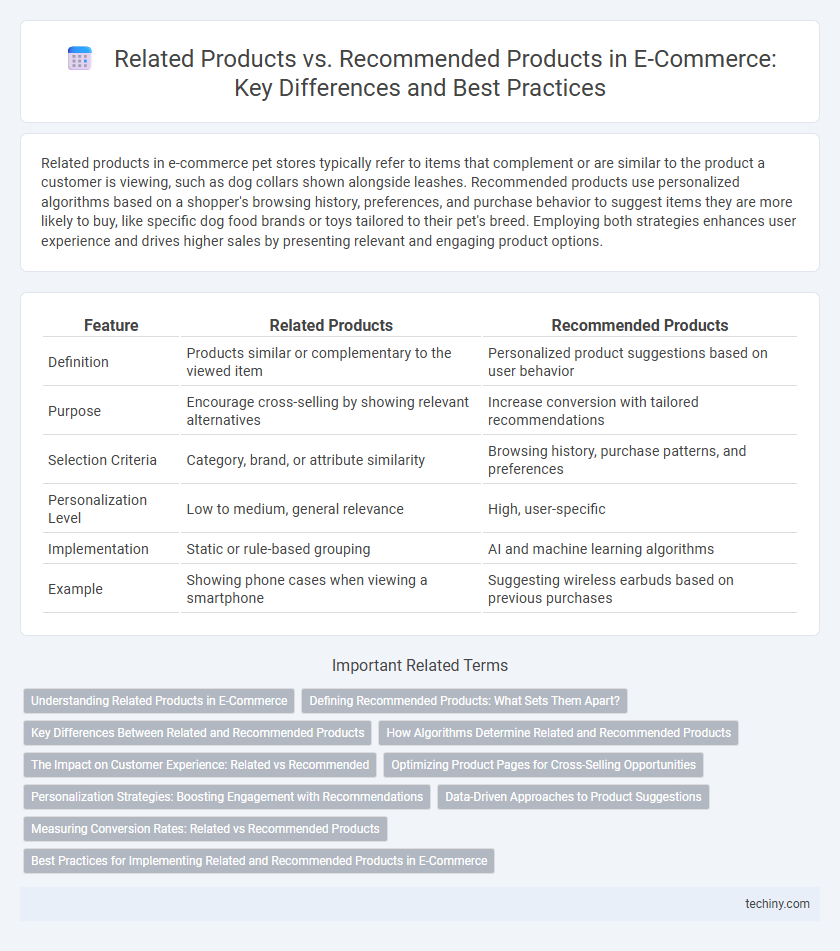Related products in e-commerce pet stores typically refer to items that complement or are similar to the product a customer is viewing, such as dog collars shown alongside leashes. Recommended products use personalized algorithms based on a shopper's browsing history, preferences, and purchase behavior to suggest items they are more likely to buy, like specific dog food brands or toys tailored to their pet's breed. Employing both strategies enhances user experience and drives higher sales by presenting relevant and engaging product options.
Table of Comparison
| Feature | Related Products | Recommended Products |
|---|---|---|
| Definition | Products similar or complementary to the viewed item | Personalized product suggestions based on user behavior |
| Purpose | Encourage cross-selling by showing relevant alternatives | Increase conversion with tailored recommendations |
| Selection Criteria | Category, brand, or attribute similarity | Browsing history, purchase patterns, and preferences |
| Personalization Level | Low to medium, general relevance | High, user-specific |
| Implementation | Static or rule-based grouping | AI and machine learning algorithms |
| Example | Showing phone cases when viewing a smartphone | Suggesting wireless earbuds based on previous purchases |
Understanding Related Products in E-Commerce
Related products in e-commerce refer to items that share similar attributes, categories, or complementary functions, often displayed on product pages to encourage cross-selling. These products are algorithmically linked based on purchase history, browsing behavior, or catalog taxonomy to enhance shopping relevance and increase average order value. Understanding related products enables retailers to create targeted marketing strategies that improve user experience and drive incremental revenue.
Defining Recommended Products: What Sets Them Apart?
Recommended products use advanced algorithms analyzing individual user behavior, purchase history, and preferences to deliver personalized suggestions that increase conversion rates. They differ from related products, which are generally static and based on product category or complementary items without user-specific data integration. Personalized recommendations leverage machine learning to dynamically adapt and optimize offers, enhancing customer engagement and boosting average order value.
Key Differences Between Related and Recommended Products
Related products are items that share similar attributes or categories with the viewed product, often appearing as complementary or alternative options to enhance user selection. Recommended products leverage user behavior data, purchase history, and AI algorithms to personalize suggestions tailored to individual preferences and shopping patterns. The key difference lies in the basis of selection: related products are product-centric and fixed, while recommended products are dynamic and user-centric, optimizing cross-selling and customer experience.
How Algorithms Determine Related and Recommended Products
Algorithms determine related products by analyzing customer behavior, product attributes, and purchase history to identify items with similar features or complementary uses. Recommended products are generated using collaborative filtering, machine learning models, and user interaction patterns to personalize suggestions based on individual preferences and trends. Both approaches rely heavily on data mining and pattern recognition to optimize cross-selling and enhance the shopping experience in e-commerce platforms.
The Impact on Customer Experience: Related vs Recommended
Related products are items similar or complementary to the one viewed, enhancing upselling opportunities and encouraging broader browsing. Recommended products leverage algorithms analyzing customer behavior and preferences to deliver personalized suggestions, increasing purchase likelihood and customer satisfaction. Both strategies improve customer experience by guiding shopping decisions, but personalized recommendations typically drive higher engagement and conversion rates.
Optimizing Product Pages for Cross-Selling Opportunities
Related products display items that share similar features or categories with the viewed product, increasing the chance of purchase by highlighting complementary or alternative options. Recommended products use personalized algorithms based on user behavior and purchase history to suggest highly relevant items, driving higher engagement and conversion rates. Optimizing product pages with both related and recommended product sections enhances cross-selling opportunities, boosts average order value, and improves customer experience on e-commerce platforms.
Personalization Strategies: Boosting Engagement with Recommendations
Related products are typically determined by product attributes or purchase history, offering customers complementary or similar items that enhance cross-selling opportunities. Recommended products leverage advanced personalization algorithms analyzing user behavior, preferences, and real-time data to deliver tailored suggestions that increase engagement and conversion rates. Implementing dynamic recommendation engines in e-commerce platforms drives higher customer satisfaction, repeat purchases, and overall revenue growth.
Data-Driven Approaches to Product Suggestions
Related products leverage historical purchasing patterns and product associations to dynamically display items frequently bought together, enhancing cross-selling opportunities. Recommended products utilize advanced machine learning algorithms and user behavior analytics, such as browsing history and demographic data, to deliver personalized suggestions that increase conversion rates. Integrating both data-driven approaches improves e-commerce platforms' ability to optimize product discovery and boost average order value.
Measuring Conversion Rates: Related vs Recommended Products
Measuring conversion rates for related products versus recommended products involves analyzing user engagement and purchase behavior metrics such as click-through rates (CTR), add-to-cart rates, and actual sales conversions. Related products typically focus on items similar or complementary to the viewed product, often resulting in higher relevance and conversion due to immediate contextual fit. Recommended products leverage personalized algorithms considering user history and preferences, which may boost long-term conversion rates by enhancing user experience and increasing cross-selling opportunities.
Best Practices for Implementing Related and Recommended Products in E-Commerce
Implementing related and recommended products in e-commerce requires leveraging customer behavior data and purchase history to enhance personalization and increase average order value. Utilizing machine learning algorithms to dynamically update recommendations based on real-time user interactions improves relevance and conversion rates. Ensuring clear product categorization and seamless integration within product pages can optimize user experience and drive cross-selling opportunities.
Related Products vs Recommended Products Infographic

 techiny.com
techiny.com